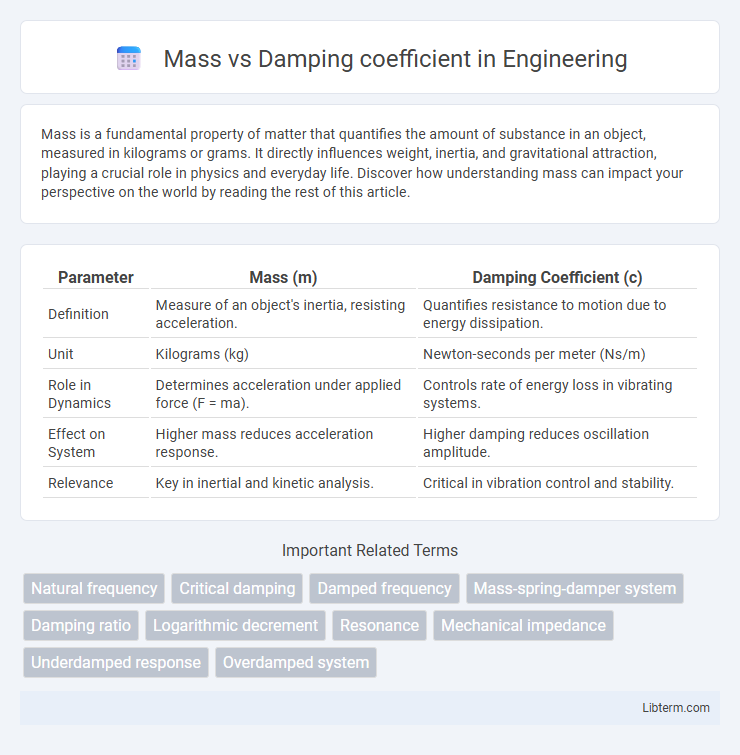Mass is a fundamental property of matter that quantifies the amount of substance in an object, measured in kilograms or grams. It directly influences weight, inertia, and gravitational attraction, playing a crucial role in physics and everyday life. Discover how understanding mass can impact your perspective on the world by reading the rest of this article.
Table of Comparison
| Parameter | Mass (m) | Damping Coefficient (c) |
|---|---|---|
| Definition | Measure of an object's inertia, resisting acceleration. | Quantifies resistance to motion due to energy dissipation. |
| Unit | Kilograms (kg) | Newton-seconds per meter (Ns/m) |
| Role in Dynamics | Determines acceleration under applied force (F = ma). | Controls rate of energy loss in vibrating systems. |
| Effect on System | Higher mass reduces acceleration response. | Higher damping reduces oscillation amplitude. |
| Relevance | Key in inertial and kinetic analysis. | Critical in vibration control and stability. |
Introduction to Mass and Damping Coefficient
Mass represents the quantity of matter in an object and significantly influences its inertia, determining how it responds to applied forces. The damping coefficient quantifies the resistance a system exerts against motion, dissipating energy and controlling oscillations in mechanical systems. Understanding the interplay between mass and damping coefficient is essential for optimizing system stability and dynamic response in engineering design.
Fundamental Concepts of Mass
Mass represents the amount of matter in an object and directly influences its inertia, determining how much force is needed to change its motion. The damping coefficient quantifies the resistance force opposing velocity, affecting the system's energy dissipation and oscillation decay. In dynamic systems, increasing mass typically lowers natural frequency, while damping coefficient controls how quickly vibrations are suppressed, critical for system stability and response.
Understanding the Damping Coefficient
The damping coefficient quantifies the resistive force opposing motion in oscillatory systems, directly impacting the rate of energy dissipation. It determines how quickly vibrations diminish, with higher values leading to faster stabilization and reduced amplitude over time. Understanding the relationship between mass and damping coefficient is crucial for designing systems with optimal performance and controlled oscillations.
Mass and Its Role in Dynamic Systems
Mass in dynamic systems determines the inertia, influencing how the system resists acceleration when subjected to external forces. Higher mass increases the system's natural frequency and affects the amplitude and phase of oscillations, playing a critical role in vibration analysis and control. Understanding the mass is essential for designing systems that require precise dynamic response, such as automotive suspensions and structural engineering applications.
Impact of Damping Coefficient on Oscillations
The damping coefficient significantly influences oscillation behavior by controlling the rate at which energy dissipates in a system. Higher damping coefficients reduce the amplitude of oscillations more rapidly, leading to quicker stabilization and less prolonged vibrations. In contrast, lower damping coefficients allow sustained oscillations with slower energy loss, resulting in longer-lived vibratory motion.
Differences Between Mass and Damping Coefficient
Mass represents the quantity of matter in an object and directly influences its inertia in mechanical systems, measured in kilograms. The damping coefficient quantifies the resistive force opposing motion, typically in units of Newton-seconds per meter, and affects how quickly oscillations diminish. Unlike mass, which stores kinetic energy, the damping coefficient dissipates energy, controlling vibration amplitude and system stability.
Mathematical Relationship: Mass vs Damping Coefficient
The mathematical relationship between mass (m) and damping coefficient (c) in a mechanical system is often defined by the damping ratio (z), given by z = c / (2(mk)), where k is the stiffness coefficient. Increasing mass reduces the system's natural frequency (o_n = (k/m)) while the damping coefficient directly affects the rate of energy dissipation, influencing how quickly oscillations decay. Optimizing the balance between mass and damping coefficient is critical for achieving desired dynamic responses in vibration control and mechanical design.
Effects on System Response: Mass vs Damping
Mass directly influences the inertia of a system, causing slower acceleration and increased oscillation periods, while the damping coefficient controls energy dissipation, reducing amplitude and stabilizing oscillations. Higher mass results in lower natural frequencies, leading to prolonged vibrations, whereas increased damping reduces peak response and prevents excessive oscillatory motion. Optimal balance between mass and damping is critical for achieving desired dynamic performance and minimizing resonance effects in mechanical and structural systems.
Practical Applications in Engineering and Physics
Mass and damping coefficient play critical roles in designing mechanical systems to control vibrations and enhance stability in engineering applications such as automotive suspension, aerospace structures, and building foundations. Precise tuning of the damping coefficient relative to mass helps mitigate resonance and improve system longevity by dissipating kinetic energy efficiently. In physics, the balance between mass and damping is fundamental in harmonic oscillators and wave propagation studies, directly influencing oscillation amplitude and decay rates in real-world scenarios.
Conclusion: Balancing Mass and Damping Coefficient
Balancing mass and damping coefficient is critical for optimizing system stability and response time in mechanical and structural dynamics. Increasing mass generally reduces natural frequency, while an optimal damping coefficient minimizes oscillations without causing excessive energy loss. Precise calibration of these parameters improves performance by enhancing vibration control and preventing resonance-induced failures.
Mass Infographic

 libterm.com
libterm.com